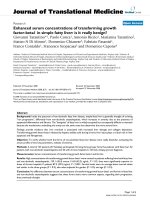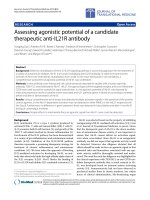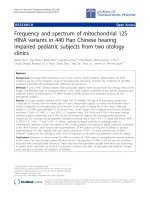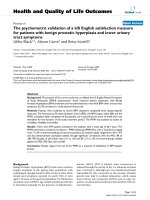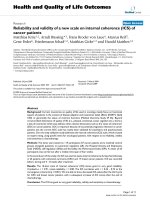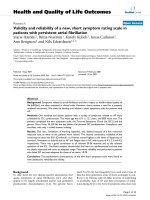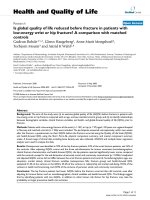Báo cáo hóa học: " Linear Rashba Model of a Hydrogenic Donor Impurity in GaAs/GaAlAs Quantum Wells" potx
Bạn đang xem bản rút gọn của tài liệu. Xem và tải ngay bản đầy đủ của tài liệu tại đây (257.18 KB, 3 trang )
NANO EXPRESS
Linear Rashba Model of a Hydrogenic Donor Impurity
in GaAs/GaAlAs Quantum Wells
Shu-Shen Li Æ Jian-Bai Xia
Received: 8 November 2008 / Accepted: 19 November 2008 / Published online: 4 December 2008
Ó to the authors 2008
Abstract The Rashba spin-orbit splitting of a hydrogenic
donor impurity in GaAs/GaAlAs quantum wells is inves-
tigated theoretically in the framework of effective-mass
envelope function theory. The Rashba effect near the
interface between GaAs and GaAlAs is assumed to be a
linear relation with the distance from the quantum well
side. We find that the splitting energy of the excited state is
larger and less dependent on the position of the impurity
than that of the ground state. Our results are useful for the
application of Rashba spin-orbit coupling to photoelectric
devices.
In the framework of effective-mass envelope–function
theory, excluding the relativity effect, the electronic states
have been studied for a hydrogenic donor impurity in
quantum wells (QWs) [1–5] and its important application
in the photoelectric devices. The relativity effect introduces
evidence of Rashba effects in the semiconductor materials.
In recent years, spin-dependent phenomena was also pro-
posed using spin field-effect transistor based on the fact
that spin precession can be controlled by an external field
due to the spin-orbit interaction [6]. Gvozdic
´
et al. studied
efficient switching of Rashba spin splitting in wide mod-
ulation-doped quantum wells [7]. They demonstrated that
the size of the electric-field induced Rashba spin splitting
in an 80-nm wide modulation-doped InGaSb QW depends
strongly on the spatial variation of the electric field.
The interplay between Rashba, Dresselhaus, and
Zeeman interactions in a QW submitted to an external
magnetic field was studied by means of an accurate ana-
lytical solution of the Hamiltonian [8]. Hashimzade et al.
presented a theoretical study of the electronic structure of a
CdMnTe quantum dot with Rashba spin-orbit coupling in
the presence of a magnetic field. The multiband k Áp theory
was used to describe electrons in Rashba spin-orbit cou-
pling regimes and an external magnetic field[9]. However,
most importantly, many researchers anticipate that Rashba
effects can introduce spin splitting of electron energy levels
in zero magnetic field.
The Rashba term is caused by structural asymmetry,
which is a position dependent quantity in a QW, significant
near the interface but quickly falling to zero away from the
interface. The electron position in the well can be modu-
lated by the impurity center and will sensitively change the
Rashba spin-orbit splitting energy.
In this letter, we will introduce a linear Rashba spin-
orbit coupling module dependent on the electron position
in a QW and study the change in spin-orbit splitting energy
as the impurity position and the QW width change.
For a hydrogenic donor impurity located at r
0
= (0, 0,
z
0
) in a GaAs/GaAlAs QW, the electron envelope function
equation in the framework of the effective-mass approxi-
mation is
4À
2
jr Àr
0
j
þ a
R
ðzÞðr ÂpÞþVðrÞ
!
w
n
ðrÞ¼E
n
w
n
ðrÞ;
ð1Þ
where 4¼Àd
2
=dx
2
À d
2
=dy
2
À d
2
=dz
2
; r ¼ðx; y; zÞ; r ¼
ffiffiffiffiffiffiffiffiffiffiffiffiffiffiffiffiffiffiffiffiffiffiffiffi
x
2
þ y
2
þ z
2
p
; and jr À r
0
j¼
ffiffiffiffiffiffiffiffiffiffiffiffiffiffiffiffiffiffiffiffiffiffiffiffiffiffiffiffiffiffiffiffiffiffiffiffiffi
x
2
þ y
2
þðz Àz
0
Þ
2
q
: The
third item in Eq. 1 is the contribution of the Rashba spin-
orbit effect to the single electron Hamiltonian. a
R
ðzÞ, r, and
S S. Li (&) Á J B. Xia
State Key Laboratory for Superlattices and Microstructures,
Institute of Semiconductors, Chinese Academy of Sciences,
P.O. Box 912, Beijing 100083, People’s Republic of China
e-mail:
123
Nanoscale Res Lett (2009) 4:178–180
DOI 10.1007/s11671-008-9222-5
p, respectively, are the Rashba parameter, the Pauli
matrices, and electron momentum operator, respectively.
The subscript n = 0, 1, 2, corresponds to the ground-,
first excited-, second-, excited states. The units for
length and energy are in terms of the effective Bohr radius
a
Ã
¼ "h
2
=m
Ã
e
e
2
and the effective Rydberg constant
R
Ã
¼ "h
2
=2m
Ã
e
a
Ã2
, where m
Ã
e
and are the effective mass and
dielectric constant of an electron.
We adopt the square potential energy model as
VðrÞ¼
0 for jzj W=2;
V
0
for jzj[W=2;
&
ð2Þ
where W and V
0
are the width of the QW and the band
offset of the electron, respectively.
We introduce a linear Rashba spin-orbit effect model
a
R
ðzÞ¼
a
0
ð1 Àj
j2zj
W
À 1jÞ for jzj W;
0 for jzj[W;
(
ð3Þ
where a
0
is the maximum value of the Rashba spin-orbit
effect at the side of the QW. The Rashba parameter is a
function of z and is dependent on the size of the QW, which
is demonstrated in Fig. 1.
In the following sections, using the normalized plane–
wave expansion method [10–12], we give numerical results
for the Rashba spin-orbit splitting energy of a hydrogenic
donor impurity in a GaAs=Ga
0:65
Al
0:35
As QW. We take the
effective mass parameters of [13] and the Rashba param-
eter a
0
¼ 10
À12
eV m [14].
The spin-orbit splitting energy C is defined by the dif-
ference between the two splitting energy levels. Figure 2
shows the change in spin-orbit splitting energy C as the
GaAs QW width increases for a hydrogenic donor impurity
at the QW center under the linear Rashba model along the z
direction. The Rashba spin-orbit splitting energy is very
small for the narrow QWs. As the well width increases
from zero, the splitting energy of the ground state increases
first, then reaches a maximum value before decreasing
monotonously. This is because the wave function of the
ground state is localized at the QW center for the impurity
at the QW center and the Rashba effects is very small at the
QW center for the wide QWs. However, for the excited
states, the wave functions are spread in space and the
Rashba effects can affect the excited states for the wide
QWs. So the spin-orbit splitting energies of the excited
states decrease more slowly than that of the ground state.
The spin-orbit splitting energy C of the ground state
decreases when the impurity moves to the QW side and the
α(z)
α
0
0
W/2
-W/2
W
-W
Fig. 1 The Rashba parameter as a function of z. The horizontal and
vertical dashed lines indicate the value of a
0
and the borderline of the
QW, respectively
0 5 10 15 20
0.0
0.5
1.0
1.5
Γ
n
(meV)
W (nm)
Fig. 2 The change in spin-orbit splitting energy C as the GaAs QW
width increases when the hydrogenic donor impurity is at the QW
center under the linear Rashba model along the z direction. The low to
top lines correspond to the ground state (n = 0), the first excited state
(n = 1), the second excited state (n = 2), and the third excited states
(n = 3), respectively
0.0 0.1 0.2 0.3 0.4 0.5
0.0
0.5
1.0
1.5
Γ
n
(meV)
Z
0
/W
W = 10 nm
Fig. 3 The change in spin-orbit splitting energy C as the position of
the impurity under the linear Rashba model along the z direction
changes, when the GaAs QW width W equals 5 nm. The low to top
lines correspond to the ground state (n = 0), the first excited state
(n = 1), the second excited state (n = 2), and the third excited states
(n = 3), respectively
Nanoscale Res Lett (2009) 4:178–180 179
123
impurity positions in the QW do not sensitively affect the
spin-orbit splitting energy C of the excited states. This is
because the ground state is more localizing than the excited
states in QWs. These changing trends are found in Fig. 3.
In summary, we proposed a linear Rashba model along
the z direction and calculated the splitting energy of a
hydrogenic donor impurity in a GaAs/GaAlAs QW. We
found that the Rashba spin-orbit splitting energy of the
ground state is more sensitively dependent on the QW
width and the center position of the hydrogen donor
impurity than those of the excited states.
Acknowledgments This work was supported by the National Nat-
ural Science Foundation of China under Grant Nos. 60776061, and
60521001.
References
1. G. Bastard, Phys. Rev. B 24, 4714 (1981)
2. C. Mailhiot, Y.C. Chang, T.C. McGill, Phys. Rev. B 26, 4449
(1982)
3. C. Mailhiot, Y.C. Chang, T.C. McGill, Surf. Sci. 113, 161 (1982)
4. R.L. Greene, K.K. Bajaj, Solid State Commun. 45, 825 (1983)
5. R.L. Greene, K.K. Bajaj, Phys. Rev. B 31, 913 (1985)
6. S. Murakami, N. Nagaosa, S.C. Zhang, Science 301, 1348 (2003)
7. D.M. Gvozdic
´
, U. Ekenberga, Appl. Phys. Lett. 90, 053105
(2007)
8. E. Lipparini, M. Barranco, F. Malet, M. Pi, L. Serra, Phys. Rev. B
74, 115303 (2006)
9. F.M. Hashimzade, A.M. Babayev, B.H. Mehdiyev, Phys. Rev. B
73, 245321 (2006)
10. M.A. Cusack, P.R. Briddon, M. Jaros, Phys. Rev. B 54, R2300
(1996)
11. S.S. Li, J.B. Xia, J. Appl. Phys. 100, 083714 (2006)
12. S.S. Li, J.B. Xia, Phys. Lett. A 366, 120 (2007)
13. I. Vurgaftmana, J.R. Meyer, J. Appl. Phys. 89, 5815 (2001)
14. T. Hassenkam, S. Pedersen, K. Baklanov, A. Kristensen, C.B.
Sorensen, P.E. Lindelof, F.G. Pikus, G.E. Pikus, Phys. Rev. B 55,
9298 (1997)
180 Nanoscale Res Lett (2009) 4:178–180
123
